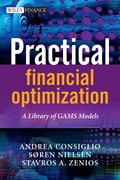
Practical financial optimization: a libreary of GAMS models
Consiglio, Andrea
Nielsen, Soren
In Practical Financial Optimization: A Library of GAMS Models, the authors provide a diverse set of models for portfolio optimization, based on the GeneralAlgebraic Modelling System. 'GAMS' consists of a language which allows a high-level, algebraic representation of mathematical models and a set of solvers numerical algorithms to solve them. The system was developed in response to theneed for powerful and flexible front-end tools to manage large, real-life models. The work begins with an overview of the structure of the GAMS language, and discusses issues relating to the management of data in GAMS models. The authors provide models for mean-variance portfolio optimization which address thequestion of trading off the portfolio expected return against its risk. Fixedincome portfolio optimization models perform standard calculations and allow the user to bootstrap a yield curve from bond prices. Dedication models allow for standard portfolio dedication with borrowing and re-investment decisions, and are extended to deal with maximisation of horizon return and to incorporate various practical considerations on the portfolio tradeability. Immunizationmodels provide for the factor immunization of portfolios of treasury and corporate bonds. The scenario-based portfolio optimization problem is addressed with mean absolute deviation models, tracking models, regret models, conditionalVaR models, expected utility maximization models and put/call efficient frontier models. The authors employ stochastic programming for dynamic portfolio optimization, developing stochastic dedication models as stochastic extensions of the fixed income models discussed in chapter 4. Two-stage and multi-stage stochastic programs extend the scenario models analysed in Chapter 5 to allow dynamic rebalancing of portfolios as time evolves and new information becomes known. Models for structuring index funds and hedging interest rate risk on international portfolios are also provided. The final chapter provides a set of ‘case studies’: models for large-scale applications of portfolio optimization, which can be used as the basis for the development of business support systems to suit any special requirements, including models for the management of participating insurance policies and personal asset allocation. The title will be avaluable guide for quantitative developers and analysts, portfolio and asset managers, investment strategists and advanced students of finance.
- ISBN: 978-1-4051-3371-5
- Editorial: John Wiley & Sons
- Encuadernacion: Cartoné
- Páginas: 177
- Fecha Publicación: 01/10/2009
- Nº Volúmenes: 1
- Idioma: Inglés
